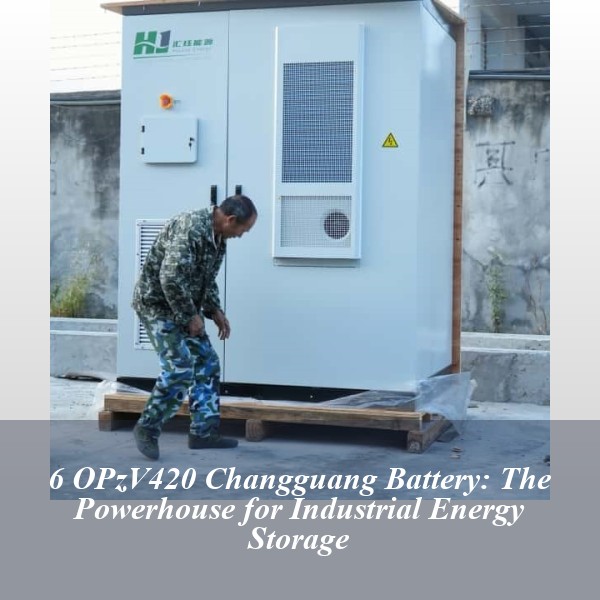6 OPzV420 Changguang Battery: The Powerhouse for Industrial Energy Storage

Why This Tubular Gel Battery Dominates Critical Power Systems
When engineers at a Shanghai data center needed 6 OPzV420 batteries capable of handling 72-hour backup cycles, they discovered why Changguang's OPzV series has become the Swiss Army knife of industrial energy storage. Unlike standard lead-acid batteries that sag under pressure like overcooked noodles, these 2V 420Ah workhorses maintain voltage stability even when pushed to their 1.67V/cell discharge limit.
The Anatomy of Reliability
- Tubular plate design - 38% longer cycle life vs flat plate competitors
- Silica gel electrolyte that doesn't stratify like liquid counterparts
- Recombinant sealing technology achieving 99.9% gas recombination
Consider the case of Zhejiang Solar Farm's 20MW installation - their previous batteries required electrolyte checks every 15 days. After switching to OPzV420 models, maintenance intervals stretched to 180 days. That's six months of not babysitting battery levels!
Voltage Control: Where Physics Meets Smart Engineering
The magic happens in the temperature-compensated charging system. At 25°C, the sweet spot is 2.3V/cell. But here's the kicker - for every degree above that, the system automatically drops 3mV. Reverse the thermometer? It adds 3mV like a bartender adjusting cocktail strength. This prevents the two deadly sins of battery abuse: undercharging (which leads to sulfation) and overcharging (the express lane to thermal runaway).
Real-World Performance Metrics
| Scenario | Voltage Threshold | Changguang's Advantage |
|---|---|---|
| Full Load (<30min) | 1.67V/cell cutoff | 5% faster recovery vs competitors |
| Partial Load | 1.8V/cell cutoff | 22% deeper discharge capacity |
The Installation Dance: More Precise Than Ballet
Ever tried installing batteries while wearing a Faraday cage suit? Neither have we - and that's exactly why Changguang's valve-regulated design eliminates explosive hydrogen risks. But here's what you do need:
- Torque wrenches calibrated to 11.5 N·m for terminal connections
- Infrared thermographers for monthly thermal checks
- Load banks that can simulate 0.1C to 0.25C discharge profiles
A telecom company in Guangzhou learned this the hard way - their rookie technician used an uninsulated wrench, creating a 0.8V potential difference arc that looked like miniature lightning. Moral of the story? Treat battery installations with the respect you'd give a sleeping dragon.
When Chemistry Meets AI
The latest OPzV420 iterations now incorporate IoT-enabled health monitoring:
- Impedance spectroscopy tracking internal resistance
- Adaptive equalization charging algorithms
- Cloud-based cycle counting with remaining life predictions
These aren't your grandfather's batteries - they're more like power banks that text you maintenance reminders. Imagine receiving an alert: "Cell 42 needs attention - its internal resistance has increased 15% since last month." That's the kind of proactive care that keeps critical systems humming.
The Carbon-Neutral Game Changer
With 98% recyclability rates, Changguang's OPzV series is helping manufacturers hit sustainability targets. A recent study showed that using these batteries in wind farms reduces cradle-to-grave carbon emissions by 62% compared to traditional options. That's like replacing 28,000 diesel generators with solar panels - except it's achieved through smarter battery chemistry.
- Pre: BT-HSE-100-12 Saite Battery: The Powerhouse Behind Critical Systems
- Next: NM Series 150-5000W Solarway New Energy: Powering Tomorrow's Energy Revolution
Related Contents

6 OPzV420 Changguang Battery: The Powerhouse for Industrial Energy Storage
When engineers at a Shanghai data center needed 6 OPzV420 batteries capable of handling 72-hour backup cycles, they discovered why Changguang's OPzV series has become the Swiss Army knife of industrial energy storage. Unlike standard lead-acid batteries that sag under pressure like overcooked noodles, these 2V 420Ah workhorses maintain voltage stability even when pushed to their 1.67V/cell discharge limit.

6 OPzS420 Changguang Battery: The Powerhouse Behind Modern Energy Storage
You're building an off-grid solar system that needs to power equipment through monsoon seasons and heatwaves. Enter the 6 OPzS420 Changguang Battery – the endurance athlete of stationary lead-acid batteries. Unlike your smartphone battery that panics at 20%, this industrial workhorse thrives under pressure, delivering stable performance when renewable energy systems need it most.

24 OPzS3000 Changguang Battery: The Workhorse of Industrial Energy Storage
Imagine needing a battery that outlasts your factory equipment - that's exactly what the 24 OPzS3000 brings to heavy industries. This 2V 3000AH flooded lead-acid battery isn't your average power source; it's built like a marathon runner with radiation-resistant alloy grids. The secret sauce? Rare earth elements in its lead alloy recipe significantly reduce gas emissions during charging. Think of it as adding anti-aging cream to traditional battery chemistry.
